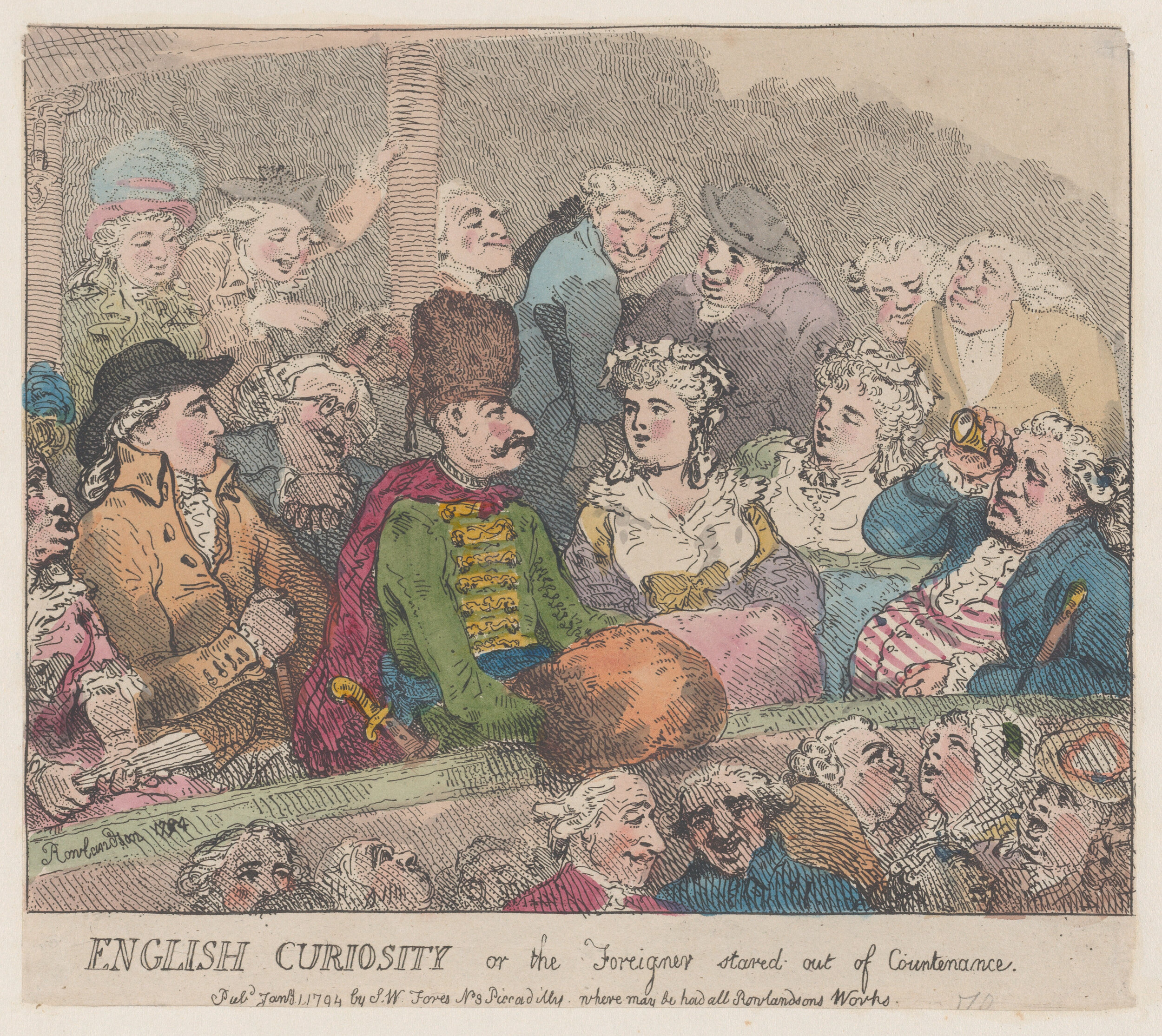*dhwer-
This is the Proto-Indo-European root that gave us both the word door and the word foreign. Funnily enough, the former comes to us through Proto-Germanic and the latter through French from Latin. They are cousins who were separated and met again in a different language, place and time. These are ten works that deal with how foreigners depict foreigners.
James Tissot. In Foreign Climes. 1881. Yale University Art Gallery.
“In Foreign Climes” (1881) by James Tissot
This etching, made in France and on paper, warns of the dangers of “riotous living” that await those who leave home for far distant countries. The seated European is an expat, not an immigrant––a spectator, not a performer. The dissimilarity in the men’s looks is contrasted by the uniformity in the local women’s presentation.
“Foreign Grooms” (ca. 760) Tang Dynasty. Indianapolis Museum of Art.
“Foreign Grooms” (ca. 760) Tang Dynasty
Marriage with outsiders proved to be of great interest to the Chinese, for whom questions of ethnicity carry mighty weight still today. These earthenware figures betray the men’s foreignness not only through their exaggerated features but also through their body language and overall maladroitness. They almost seem not to be in on a joke that is about them.
“The Disillusioned Medea” (ca.. 1640) by Paulus Bor. The Metropolitan Museum of Art.
“The Disillusioned Medea” (ca.. 1640) by Paulus Bor
An age-old archetype in Europe for the crazed foreign woman, Medea here is shown as the antithesis to that deranged barbarian who murders her own children. Only her garb, exposed breast and pagan relics betray her foreignness. We see her in complete inertia, perhaps even boredom. She is alone in a foreign land, yet holds power and status. We see her languish in her solitude, after being betrayed but before enacting her revenge.
“English Curiosity” or “The Foreigner Stared Out of Countenance” (1794) by Thomas Rowlandson. The Metropolitan Museum of Art.
“English Curiosity” or “The Foreigner Stared Out of Countenance” (1794) by Thomas Rowlandson
This hand-colored etching shows a central figure whose exotic headwear, facial hair and attire make him of great interest to everyone around him, completely taken and amused by his presence. The man on the right seems to have found a better use for his spyglass. Curiosity was yet another luxury the British could afford.
Jacopo Ligozzi (Italian, 1547 - 1627). An Azappo Archer with a Cheetah, about 1575, Brush, pen and brown ink, tempera colors, and painted gold. The J. Paul Getty Museum, Los Angeles
“An Azappo Archer with a Cheetah” (ca. 1575) by Jacopo Ligozzi
This painting depicts a maritime Turkish archer whose attire would have been as exotic as his animal companion. The artist seems to have had a penchant for pairing up strange animals and costumes. We can see the preternaturally human-like attributes of the cheetah echo the human subject’s countenance.
“A European Couple” (c. 1610-1627) by Ali Riza. Cleveland Museum of Art.
“A European Couple” (c. 1610-1627) by Ali Riza
This drawing depicts a man and woman with garb that is completely foreign to India, but nevertheless closely examined, studied and reproduced. The attention to detail in the clothing and jewelry reveals the need to depict those aspects, rather than the faces, accurately. There is something to be said as well for the lack of ambiance and minimal scenery.
“A Wicked Foreigner Refuses to Pay a Young Prostitute” (1875) by Tsukioka Yoshitoshi. LACMA.
“A Wicked Foreigner Refuses to Pay a Young Prostitute” (1875) by Tsukioka Yoshitoshi
This woodblock print depicts a foreigner in Japan not after its centuries-long policy of isolation was brought to an end. The European man in question has one hand on the door, one foot on the floor, another foot in the air and his other hand on his cane. His frantic scrambling to escape is contrasted by the Japanese woman’s direction of motion.
“Marie Antoinette in a Park” (ca. 1780-1781) by Elisabeth Louise Vigée Le Brun. Metropolitan Museum of Art.
“Marie Antoinette in a Park” (ca. 1780-1781) by Elisabeth Louise Vigée Le Brun
Le Brun was commissioned by the royal family for more than twenty portraits of the ill-fated queen, whose foreign birth made her life in France more difficult. In this rare sketch, she is shown sporting a newfangled fashion trend from Poland. Critics often thought that the queen was pretending to be something she was not through the art, in a sort of modern PR stunt.
“Barbarian” (First Century) Rome, Italy. Cleveland Museum of Art.
“Barbarian” (First Century) Rome, Italy
This bronze figure may have been used as a decorative element in a military parade. Onlookers would have known that it was meant to represent a foreigner because of the kind of hat he wears. A city founded for runaways and outlaws, with a royal foreign lineage to boot, Rome continued to play with and change up the definition of barbarian in the Ancient World.
“Tokyo Kaika Kyoga Meisho” (1881) by Taiso Yoshitoshi. The Walters Art Museum.
“Tokyo Kaika Kyoga Meisho” (1881) by Taiso Yoshitoshi
This print depicts a foreign woman visiting a shrine past midnight to put a curse on a former lover, something traditionally Japanese. The foreign woman, the native Japanese man and the fox all seem surprised.










